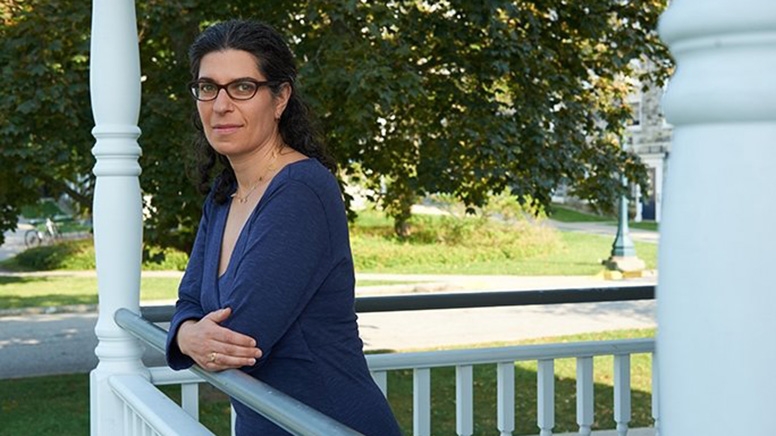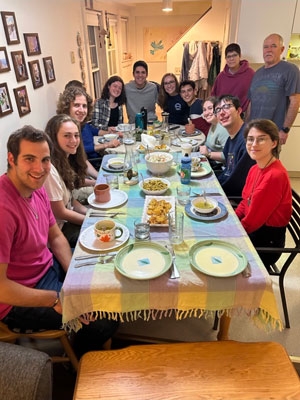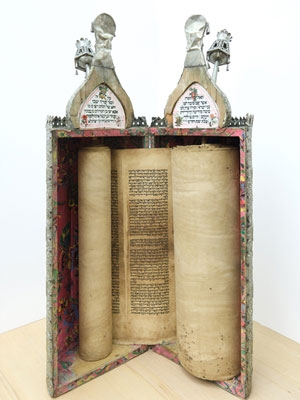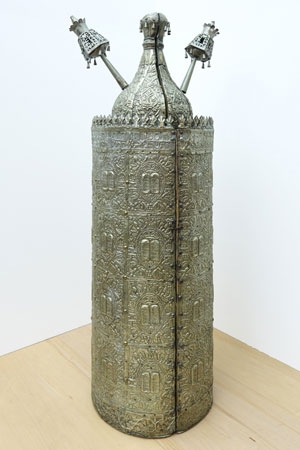Hillel Hayom

Midyear Update
Rabbi Danielle Stillman
Although we call this newsletter Hillel Hayom, this title does not really do justice to the news we share, which is about many aspects of Jewish life on campus, including, but going beyond, the student organization of Middlebury College Hillel. The multiple ways to enter into Jewish life here at Middlebury have never been more apparent, nor more important, than in this past fall semester here in Vermont.
When the news of the horrific attacks on Israelis reached us on October 7, the Middlebury community quickly acted to begin supporting students, even as some of us offering the supports were quite close to people and places affected by the attacks. Hillel offered multiple gathering and processing spaces for students, the Hebrew House made soup and invited people to come sit and cry and share news and concerns, the Office of Student Affairs checked in on who might be the most affected in our student body, and everyone I know here—from chaplains to faculty to administrators—met with students individually to lend their support. Jews and allies from across campus and town came together in a solidarity vigil in front of McCullough Student Center on October 11.
At the same time that we offered emotional support, other individuals and offices of the College came forward to offer context and ways of approaching the subject of this war and conflict. Professors who teach about the Middle East and Israel or Palestine opened their office hours to anyone who wanted to know more. The Kathryn Wasserman Davis Collaborative in Conflict Transformation began hosting dialogues to increase understanding and listening about personal connections and perspectives on the conflict.
Middlebury has not experienced some of the more public and prominent forms of protest that have been reported at other college campuses. This does not mean there were no thoughtless posts on social media or comments in dining halls or classrooms. But I do believe that the tireless work of relationship, dialogue, and promoting civil discourse has kept some of the more intimidating and overwhelming protests and antisemitic climates at bay. We hope this will continue into the spring semester, and we continue to work to encourage engagement that creates more understanding rather than less. Meanwhile, the Office of Institutional Diversity, Equity, and Inclusion has held listening space for Jewish students, Hillel offered a workshop on responding to antisemitism this past J-term, and our Coalition for Dismantling Antisemitism has begun to meet again after a period of low activity while I was on leave last year.
I hope you will see in this issue of Hillel Hayom just how many parts of the College contribute to our vibrant Jewish experience on campus. Hillel, the Hebrew Language and Culture Club, the Jewish Studies Department, and Special Collections are just some of the contributors we are highlighting here. It is good to know that the richness of and support for Jewish life on campus depend on a network of offices, initiatives, and people who are all working together. Jewish life and Jewish students are not isolated—they are an integral part of our Middlebury community.
Conflict Transformation and the Israeli-Palestinian Conflict on Campus
Rabbi Danielle Stillman
I was extremely excited when the grant that led to the formation of the Kathryn Wasserman Davis Collaborative in Conflict Transformation was announced, because I sensed that this would lead to campus partners and support for better approaches to the conflict that arises on campus when the conflict in Israel/Palestine heats up. I also knew that we had been building the capacity for this kind of difficult dialogue since 2018, when Professor of Political Science Sarah Stroup, now director of the Conflict Transformation Collaborative, began the Engaged Listening Project (ELP). This is a project that trains faculty and student-facing staff to incorporate structured reflective dialogue into their classrooms and other settings to help students have better conversations with one another when they disagree about heated topics. I’m in the current Engaged Listening Project cohort and I know I will be applying these skills to my own work this semester.
Meanwhile, my hopes for the Conflict Transformation Collaborative were not unfounded. While I was on leave in Jerusalem during the 2022–23 academic year, the newly formed collaborative began to dip its toes into Israel/Palestine work with a series of three small dinner dialogues and one-on-one conversations with stakeholders, asking this question: “How can we have a more constructive conversation at Middlebury about Israel and Palestine?” (KWD Collaborative in Conflict Transformation 2023 Annual Report, 15). I am sure that this foundation has helped our campus stay relatively calm over this most recent fall. The collaborative was able to offer three campuswide dialogues in the fall, after October 7. The first one drew 50 participants. I know that I left the two I attended feeling more heard and seen, and more hopeful. Listening to my dialogue partners challenged many of the assumptions I had made about where they were coming from, and I saw that everyone was able to try on perspectives different from their own. Knowing that they also listened to me with the same curiosity and respect gave me hope for a better approach to the conflict on campus and, maybe one day, to the conflict as a whole. May this work continue to have that effect! Learning new ways to talk about conflict takes time, but it is not impossible. The skills our students, faculty, and staff are practicing on campus not only make the campus a better place to be, but they also will transfer to wherever our students go.
You can learn more about the work of the Kathryn Wasserman Davis Collaborative in Conflict Transformation in its 2023 Annual Report.
Hebrew Language Culture Club
Evie Happel ’26
Over the past few years, Michal Strier, visiting assistant professor of Hebrew, and a group of students have been creating a variety of spaces to experience, discuss, and celebrate Israeli culture. I have had the pleasure of being a part of this family for over a year now, watching it grow from a few Hebrew Department students to a group so large we can barely fit around Michal’s dining room table.

As a resident in the Hebrew House, I now have a role in organizing learning and art events for the Hebrew Language and Culture Club, inviting speakers, showing movies, helping to host dinners, and opening our home for community hours, especially during these times of uncertainty and pain. The philosophy of our group remains true throughout any gathering: we provide one another a space of love, warmth, listening ears, and communal support for processing the world and all emotions that may arise. Our space is open to anyone, regardless of their political views, personal connections, or knowledge on the Israeli-Palestinian conflict, who is interested in learning more about Israeli culture, engaging in respectful dialogue, or becoming a part of a multigenerational, family-like community.
Jacob Shammash and the Gift of the Torah
Jessie Raymond
Jewish studies professor Robert Schine jokes that when he got the call back in 2022, he felt a bit like a hard-boiled detective: “I was sitting in my office minding my own business when the phone rang.”
But the call wasn’t about a case to be solved; it was a request for guidance from Elizabeth Shammash, a cantor and a daughter of Jacob Shammash ’51, an Iraqi Jew who in 1947 had left his home in Baghdad and made his way to Middlebury College. “She explained that she and her siblings wanted to honor their father on the occasion of his 95th birthday, which was coming up, by giving a gift to the college that meant so much to him, the place that was his introduction to America.”
The family was wondering if Schine could help them come up with a meaningful gift to the College during their father’s lifetime that would, if possible, highlight his Iraqi Jewish heritage. Schine knew exactly who could help: Rebekah Irwin, director of Special Collections.
“Rebekah, in the time that she has been here, has made Special Collections into such a treasure,” Schine says. “When I’m teaching students about the Bible and the Torah, I can go there and look at rare Hebrew books, of which there are now many, and manuscripts that she has purchased. And she’s done this in every field—not just Jewish studies. This brings things alive.” He called her and told her what the Shammash family wanted. He says, with a laugh, “That got Rebekah’s wheels turning.”
Irwin was thrilled to take on the challenge. She began poring over rare book and auction house catalogs for items from Iraq with connections to the Jewish community that had once thrived there. She knew she had little chance of finding anything still in Iraq, however. The Jewish population in that region—once known as Babylon—had dated back to the sixth century BCE, hundreds of years before Muslim communities had established a presence in Iraq. When Shammash was a boy, Iraq’s Jewish community numbered around 135,000, but, following a violent pogrom—an anti-Jewish riot against Iraq’s Jews in 1941 and in the years that followed—Jews fled the country. An estimated 120,000–130,000 Iraqi Jews escaped persecution, fleeing to the newly independent country of Israel, to Europe, and to the United States. Today, Irwin says, there are fewer than five Jews left in the whole country.
Jacob Shammash
Irwin acquired a copy of Jacob Shammash’s 2018 self-published memoir (written with daughter Amy S. Dane), From Baghdad to Boston and Beyond: Memoir of an Iraqi Jew, to learn more about the man who this gift would honor. The book told the unlikely story of how Shammash—who says in the book, “I knew I wanted to become a doctor and help other people”—ended up at Middlebury in 1947. As a Jew in 1940s Iraq, he was not likely to be welcomed at Baghdad Medical School, which enforced strict quotas on the number of Jewish students admitted. He applied first to medical schools in London and India, but found that in the postwar years, schools were giving priority enrollment to war veterans. He soon switched gears and applied to engineering schools in America. Shammash set his eyes on MIT, NYU, and Harvard—but as with schools in the U.K., American spots were reserved for GIs returning from the war.
MIT, however, told him he could increase his chances of getting in if he first attended one of the liberal arts colleges in their consortium (of which Middlebury was a member). He could earn a BA in three years at one of those schools, then transfer to MIT and get a BS in two years. He applied to Middlebury and was accepted.
In July 1947, Shammash climbed on a bus in Baghdad, leaving his parents and four siblings behind—not knowing at the time that he would never return to his homeland. He rode through Syria, then Lebanon, then boarded a retired war ship in Beirut. Stopping at ports in Palestine, Egypt, and Greece, the ship eventually crossed the Atlantic. Shammash landed in New York exactly one month after leaving home, on August 8, 1947, what he calls “the day the rest of my life began.”
Shammash took a Greyhound bus north to Middlebury, finding a landscape very different than what he had left in Iraq. In the memoir, he says, “Before school had started, I passed the days walking through the campus and soaking up my surroundings. It was all new to this boy from Baghdad. The lush scenery was just as beautiful. The Green Mountains, only a few miles away, lived up to their name.” He later recalls being equally awed by the beauty of the fall foliage and the snow.
There was no Jewish organization on campus at the time, so Shammash carried out his religious practices in whatever privacy he could find. He kept kosher by buying food from town when possible, rather than eating in the dining hall; sometimes he’d boil eggs on a hot plate in his dorm room in a glass beaker “borrowed” from the chemistry lab. Through a bit of searching and a bit of luck, he found connections with the Lazarus family in Middlebury—one of the only Jewish families in the area and owners of the town department store on Main Street—and a small Jewish congregation in Burlington.
While he didn’t consider himself particularly social as a student, he says he had “plenty of friends” at Middlebury. In the memoir, he speaks fondly of attending football games in the fall and, in the winter, skating under floodlights on a rink in front of Starr Hall. He remarks on the stark difference in climate between the Middle East and New England but embraces winter in Vermont. “Walking on the paths on cold bright days with sunlight reflecting off the snow and glinting on ice uplifted my soul.”
A Gift is Selected
Irwin says that many of the Jews who fled Iraq in the 1940s and ’50s ended up in Israel, which is where she began her search. “There’s a neighborhood outside of Tel Aviv that is primarily made up of Iraqi exiles. It’s called Little Babylon to this day. I sought out galleries and booksellers that were knowledgeable about Mizrahi Jews, the vast Jewish communities existing since ancient times across the Middle East and North Africa.”
Through her research, Irwin found a number of items with the Iraqi provenance she was looking for. But small things like prayer books weren’t enough, she decided; this gift would have to be something truly impressive. She narrowed her search down to a Torah—an immense, handwritten scroll that contains the Hebrew bible—that had originated in Iraq and found three held by a collector in Jerusalem.

In February 2023, she and Middlebury rabbi and associate chaplain Danielle Stillman, who was on sabbatical in Jerusalem for the year, visited the collector, who not only sold Torahs but also provided restoration services. Stillman and Irwin evaluated the three Torahs and settled on one. With the Shammash family’s approval, Irwin made the purchase, using funds given by the family combined with money from the Jewish Studies Program’s Saltz Judaica Fund and gift funds from Special Collections. As for Shammash, Schine says his family presented him “with a letter from the College, acknowledging the gift and congratulating him on his birthday. He was thrilled.”
The Torah had likely left Iraq in one of the waves of migration in the 20th century. “It ended up at a small synagogue in a Jewish community outside of Tel Aviv,” Irwin says. “How it ended up for sale is likely because it was no longer needed or was in need of repair.” Stillman explains why a Torah’s condition matters so much: “If there’s any kind of place in the entire scroll—which is huge—that’s hard to read, or where there’s been some erasure or some damage of the letters, it’s considered to be not kosher for reading in a synagogue service.” Irwin says the congregation that owned it would have needed to invest great funds to repair the hundred-year-old scroll or simply replace it with something new.
Irwin, however, didn’t want something new. She chose this Torah in part because of its age, not in spite of it. And she decided to use available funds from Special Collections to have it brought back to usable condition. (Although restoration is typically a painstaking process, Irwin and Stillman discovered that the gallery in Jerusalem employed a kind of facial recognition software to analyze the text, allowing scribes to quickly locate places that needed repair.)
Early last summer, the Torah arrived at Middlebury College.
The Torah Scroll at Middlebury
When I visited Irwin in Davis Family Library in January, I was surprised to see how imposing the newly acquired Torah—standing around three feet tall—looked on the table in her office. The case, a thick wooden cylinder sheathed in elaborately tooled silver, opened dramatically to reveal the Torah scroll within. The date, inscribed into the silver alongside a dedication from the donor of the Torah to his spiritual teacher, read “1912.”
This method of presenting the Torah—upright in a wooden case called a tiq in Hebrew—is a mark of the Mizrahi (Middle Eastern) Jewish tradition. Ashkenazi (Eastern European) scrolls, which are typically rolled on elaborate spindles and laid down for reading, are more common in the U.S. The College’s other Torah, for example, a gift from the late Cincinnati rabbi Victor Reichert (who summered in Ripton for many years and was a close friend of Robert Frost’s), dates to the 1700s and is in the Ashkenazi style.

Irwin and Schine see the differences between the two Torahs as a way to broaden students’ understanding of Jewish history. The onion-shaped silver dome on the top of this Torah, for instance, reflects the Middle Eastern design influences on Jews in Iraq and serves as an illustration that the Jewish culture is not a monolith. It’s a reminder that Jews lived in Arab majority countries for thousands of years, side-by-side with neighbors of many ethnic and faith traditions. While the Torah in its worn condition would have served just as well as a teaching tool, Stillman and Irwin’s decision to have it restored meant that it was able to be used for this year’s High Holidays services. “It’s actually alive again as a text,” Irwin says.
It wasn’t easy to transport the large and heavy Torah from Special Collections to the Middlebury Chapel (Irwin sheepishly mentions the use of a dolly, some moving blankets, and her Subaru), nor to lift it up, as is traditional during the Yom Kippur service. But Stillman is moved by its inclusion. “To think about such an important ritual object being put to its intended use again after a long time was really cool.”
She says the Torah also provides an opportunity for students to learn about Shammash’s experience, which may especially resonate with those Jewish students who come to college here from places with significant Jewish communities. “It’s the first time they’ve ever lived somewhere where there are 10 churches in town, but you can’t really find the synagogue, and where they don’t cancel classes for High Holidays like their public schools did.” She also likes the idea that students, most of whom are only familiar with the Ashkenazi tradition, can be introduced to a Middle Eastern Torah. “It feels like a way to continue a heritage and a legacy.”
The Shammash Family at Middlebury
During his time at Middlebury, Shammash studied hard and did well in his classes, managing to complete his undergraduate studies in two full academic years plus a summer session—a period he recalls as “among the best years of my life.”
He went on to attend not MIT but the University of Buffalo School of Medicine (now SUNY Buffalo) and become a surgeon, raising five children with his wife, Estelle, in Massachusetts. Though many decades have passed since his time as an undergraduate, his family’s connection to the College has continued. Following him at Middlebury came his nephew Felix Shammash ’77, daughter Ellen Shammash ’84, daughter Elizabeth “Lizzie” Shammash, MA Italian ’89, and granddaughter Amanda Hotvedt ’17. And now his grandson Zachary Shammash has matriculated as a member of the Class of 2028.5.
While Jacob Shammash had no prior connection to the newly acquired Torah, the gift has meaning because the two have something in common. During Rosh Hashanah services this year, Irwin gave remarks introducing the new Torah and sharing the story of Shammash’s time at Middlebury, noting that both he and the Torah came from Iraq, a place of exile, to Middlebury, a refuge.
Schine, too, finds something satisfying in their parallel journeys. “There are two migrants: the Torah scroll and Jacob Shammash. And this is one of those projects, from its beginning to its completion, that has just felt right.”

